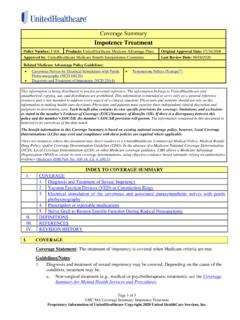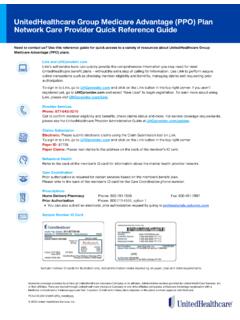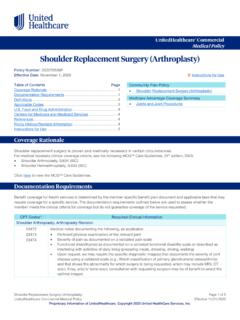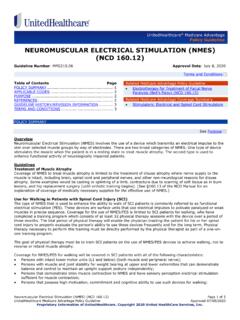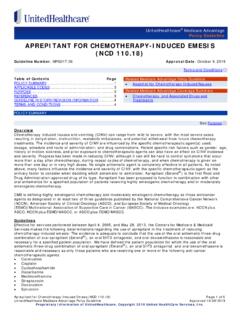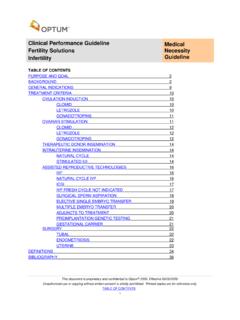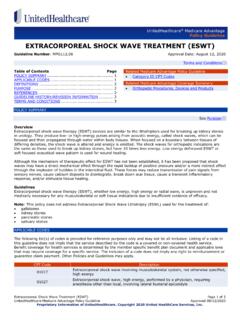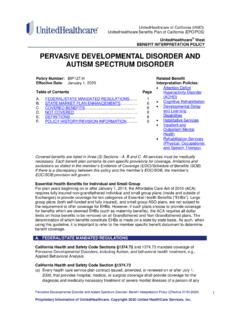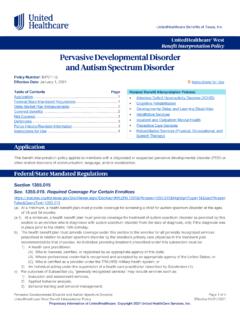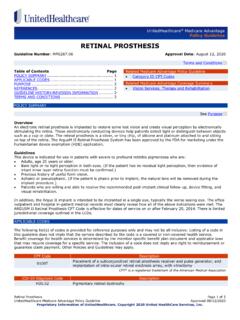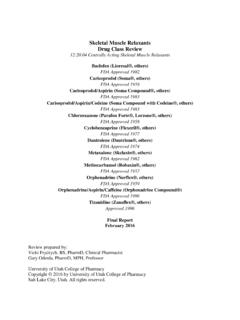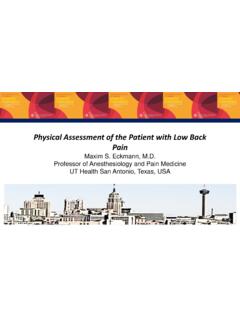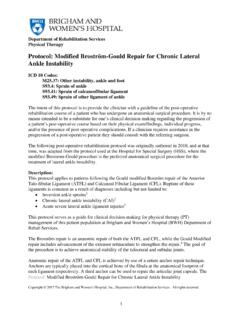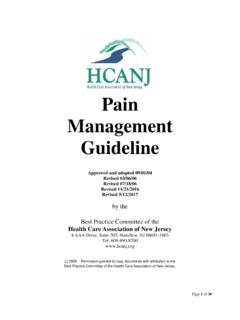Transcription of Botulinum Toxins A and B - UHCprovider.com
1 Botulinum Toxins A and B Page 1 of 24 UnitedHealthcare Commercial Medical Benefit Drug Policy Effective 04/01/2021 Proprietary Information of UnitedHealthcare. Copyright 2021 United HealthCare Services, Inc. UnitedHealthcare Commercial Medica l Benefit Drug Policy Botulinum Toxins A and B Policy Number: 2021D0017AB Effective Date: April 1, 2021 Instructions for Use Table of Contents Page Coverage Rationale .. 1 Applicable Codes .. 6 8 Benefit Considerations .. 8 Clinical Evidence .. 8 Food and Drug Administration .. 18 References .. 19 Policy History/Revision Information .. 23 Instructions for Use .. 23 Coverage Rationale See Benefit Considerations This policy refers to the following Botulinum toxin types A and B: Dysport (abobotulinumtoxinA) Xeomin (incobotulinumtoxinA) Botox (onabotulinumtoxinA) Myobloc (rimabotulinumtoxinB) The following information pertains to medical necessity review: General Requirements (applicable to all medical necessity requests) For initial therapy, both of the following: o Diagnosis; and o Medical records documenting both of the following: History and physical examination documenting the severity of the condition.
2 And Laboratory results or diagnostic evidence supporting the indication for which Botulinum toxin is requested and o Botulinum toxin administration is no more frequent than every 12 weeks, regardless of diagnosis. For continuation of therapy, both of the following: o Documentation of positive clinical response to Botulinum toxin therapy; and o Statement of expected frequency and duration of proposed Botulinum toxin treatment; and o Botulinum toxin administration is no more frequent than every 12 weeks, regardless of diagnosis. Diagnosis-Specific Requirements The information below indicates additional requirements for those indications having specific medical necessity criteria in the list of proven indications. Dysport (abobotulinumtoxinA) is proven in the treatment of the following conditions: Related Commercial Policies Occipital Neuralgia and Headache Treatment Temporomandibular Joint Disorders Community Plan Policy Botulinum Toxins A and B Botulinum Toxins A and B Page 2 of 24 UnitedHealthcare Commercial Medical Benefit Drug Policy Effective 04/01/2021 Proprietary Information of UnitedHealthcare.
3 Copyright 2021 United HealthCare Services, Inc. Achalasia81 Dysport is medically necessary for the treatment of achalasia when all of the following criteria are met: o Diagnosis of achalasia as confirmed by esophageal manometry; and o Patient has failed or is not a candidate for pneumatic dilation or myotomy; and o History of failure, contraindication, or intolerance to one of the following: Calcium channel blocker Long-acting nitrate and o Other causes of dysphagia ( , peptic stricture, carcinoma, extrinsic compression) ruled out by upper gastrointestinal endoscopy Anal fissures, chronic7,8,81 Dysport is medically necessary for the treatment of chronic anal fissures when all of the following criteria are met: o Diagnosis of chronic anal fissure.
4 And o At least 2 months of symptoms including one of the following: Nocturnal pain and bleeding Post-defecation pain and o History of failure, contraindication, or intolerance to one of the following conventional therapies: Topical nitrate Topical calcium channel blocker ( , diltiazem, nifedipine) Blepharospasm associated with dystonia10,81 Cervical dystonia (also known as spasmodic torticollis)10,19,81,83,84 Dysport is medically necessary for the treatment of cervical dystonia when both of the following criteria are met: o Diagnosis of cervical dystonia; and o Symptoms including both of the following: Sustained head tilt or abnormal posturing resulting in pain and/or functional impairment Recurrent involuntary contraction of one or more muscles of the neck ( , sternocleidomastoid, splenius, trapezius, posterior cervical) Detrusor overactivity (also known as detrusor hyperreflexia) or detrusor-sphincter dyssynergia due to spinal cord injury or disease15,17,18,53,54,63,81 Dysport is medically necessary when both of the following criteria are met: o One of the following.
5 Diagnosis of detrusor overactivity Diagnosis of detrusor-sphincter dyssynergia due to spinal cord injury or disease and o History of failure, contraindication, or intolerance to two anticholinergic medications ( , oxybutynin, trospium, darifenacin, tolterodine) Hand dystonia (writer's, musician's or typist's cramp)19,81,83 Hand tremor19,81 Hemifacial spasm (seventh cranial nerve disorders)19,81 Hyperhidrosis1,15,81 including gustatory sweating (Frey's Syndrome)9,15,38 Oromandibular dystonia Sialorrhea15,57,81 Spasmodic dysphonia (laryngeal dystonia)3,19 Spasticity associated with:1,6,39,81 o Cerebral palsy o Multiple sclerosis o Neuromyelitis optica (NMO) o Stroke o Other injury, disease, or tumor of the brain or spinal cord Botulinum Toxins A and B Page 3 of 24 UnitedHealthcare Commercial Medical Benefit Drug Policy Effective 04/01/2021 Proprietary Information of UnitedHealthcare.
6 Copyright 2021 United HealthCare Services, Inc. Strabismus1,19,81 Tongue dystonia Torsion dystonia Voice tremor4 Xeomin (incobotulinumtoxinA) is proven in the treatment of the following conditions: Blepharospasm associated with dystonia70,76 Cervical dystonia (spasmodic torticollis)70,76,83-4 Xeomin is medically necessary for the treatment of cervical dystonia (spasmodic torticollis) when both of the following criteria are met: o Diagnosis of cervical dystonia; and o Symptoms including both of the following: Sustained head tilt or abnormal posturing resulting in pain and/or functional impairment Recurrent involuntary contraction of one or more muscles of the neck ( , sternocleidomastoid, splenius, trapezius, posterior cervical) Sialorrhea70 Spasticity associated with:65-6,70,76 o Cerebral palsy o Multiple sclerosis o Neuromyelitis optica (NMO) o Stroke o Other injury, disease, or tumor of the brain or spinal cord Botox (onabotulinumtoxinA) is proven in the treatment of the following conditions: Achalasia80 Botox is medically necessary for the treatment of achalasia when all of the following criteria are met: o Diagnosis of achalasia as confirmed by esophageal manometry.
7 And o Patient has failed or is not a candidate for pneumatic dilation or myotomy; and o History of failure, contraindication, or intolerance to one of the following: Calcium channel blocker Long-acting nitrate and o Other causes of dysphagia ( , peptic stricture, carcinoma, extrinsic compression) ruled out by upper gastrointestinal endoscopy Anal fissures, chronic8,80 Botox is medically necessary for the treatment of chronic anal fissures when all of the following criteria are met: o Diagnosis of chronic anal fissure; and o At least 2 months of symptoms including one of the following: Nocturnal pain and bleeding Post defecation pain and o History of failure, contraindication, or intolerance to one of the following conventional therapies: Topical nitrates Topical calcium channel blockers ( , diltiazem, nifedipine) Blepharospasm associated with dystonia1,19,80 Cervical dystonia (also known as spasmodic torticollis)1,10,80,83-4 Botox is medically necessary for the treatment of cervical dystonia when both of the following criteria are met: o Diagnosis of cervical dystonia.
8 And o Symptoms including both of the following: Sustained head tilt or abnormal posturing resulting in pain and/or functional impairment Botulinum Toxins A and B Page 4 of 24 UnitedHealthcare Commercial Medical Benefit Drug Policy Effective 04/01/2021 Proprietary Information of UnitedHealthcare. Copyright 2021 United HealthCare Services, Inc. Recurrent involuntary contraction of one or more muscles of the neck ( , sternocleidomastoid, splenius, trapezius, posterior cervical) Detrusor overactivity (also known as detrusor hyperreflexia) or detrusor-sphincter dyssynergia due to spinal cord injury or disease15,17,18,53,54,63,80 Botox is medically necessary when both of the following criteria are met: o One of the following.
9 Diagnosis of detrusor overactivity Diagnosis of detrusor-sphincter dyssynergia due to spinal cord injury or disease and o History of failure, contraindication, or intolerance to two anticholinergic medications ( , oxybutynin, trospium, darifenacin, tolterodine) Hand dystonia (writer's, musician's or typist's cramp)19,80,83 Hand tremor19,80 Hemifacial spasm (seventh cranial nerve disorders)19,80 Hyperhidrosis1,80 including gustatory sweating (Frey's Syndrome)9,15,38 Migraine headache, chronic1,71,80 defined by all of the following: o Greater than or equal to 15 headache days per month o Greater than or equal to 8 migraine days per month o Headaches last 4 hours per day or longer Botox is medically necessary for the prophylaxis of chronic migraine when all of the following criteria are met: o Diagnosis of chronic migraine, defined by all of the following: Greater than or equal to 15 headache days per month Greater than or equal to 8 migraine days per month Headaches last 4 hours per day or longer and o History of failure (after a trial of at least two months), contraindication, or intolerance to prophylactic therapy with one agent from two of the following therapeutic classes.
10 Antidepressant [ , Elavil (amitriptyline), Effexor (venlafaxine)] Antiepileptic drug [ , Depakote/Depakote ER (divalproex sodium), Topamax (topiramate)] Beta blocker [ , atenolol, Inderal (propranolol), nadolol, timolol, Toprol XL (metoprolol extended-release)] and o Botox dose does not exceed 155 units administered intramuscularly divided over 31 injection sites divided across 7 head and neck muscles every 12 weeks Oromandibular dystonia Overactive bladder1,80 Botox is medically necessary for the treatment of overactive bladder when all of the following criteria are met: o Diagnosis of overactive bladder; and o One of the following symptoms: Urge urinary incontinence Urgency Frequency and o History of failure, contraindication, or intolerance to two anticholinergic medications ( , oxybutynin, trospium, darifenacin, tolterodine); and o Botox dose does not exceed 100 units divided over 20 injection sites every 12 weeks Sialorrhea15,57,80 Spasmodic dysphonia (laryngeal dystonia)3-5,19,80 Spasticity associated with:1,6,39,80 Botulinum Toxins A and B Page 5 of 24 UnitedHealthcare Commercial Medical Benefit Drug Policy Effective 04/01/2021 Proprietary Information of UnitedHealthcare.
